Blog
June 11th, 2009
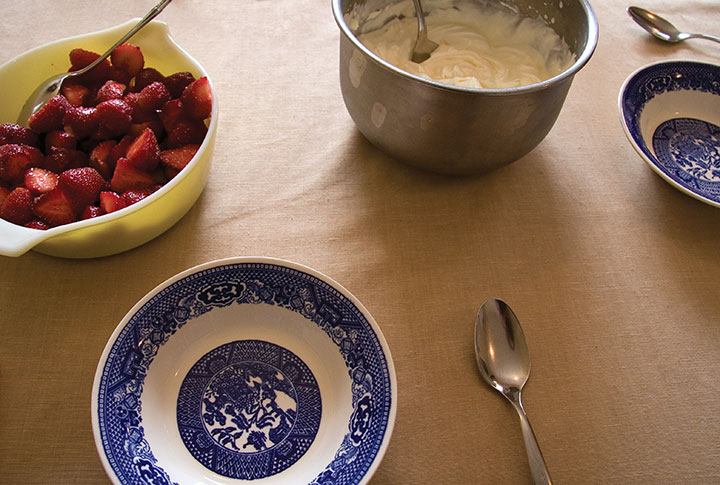
Today we dished out our first strawberries and cream of the season—cause for major celebration at our house. Now, lest you get the idea that I’m either entirely too easily amused, or have never heard of a supermarket, let me explain. The Tailor and I do our best to eat locally, organically, and seasonally—and we’re lucky to live in a part of the world with lots of like-minded people who do the same. I think, however, that we tend to fall in the, uh, hardcore variety of seasonal foodies. I’m sure this topic will crop up again in the future, so I’ll save you the spiel. For now, let’s just say that if Mount Rainier happened to go ka-blooey some winter, cutting T-Town off from any supply routes into the city, we could live on our stored food for a good three or four months before we started beadily eyeing the squirrel population. Sure, it’s probably a little nutty, but what it boils down to is the fact that we only eat asparagus in the few short weeks every year that it’s available locally—and we don’t buy any produce between November and April. So for me that first beautiful mouthful of fresh, perfect, tiny strawberries is better than any birthday present (though I admit to occasionally breaking down and impulse-buying California berries two months early when my will is weak).
All of this is to say that living seasonally certainly teaches one to learn the cycles of the year (so as not to miss the asparagus, you know), and to appreciate the best parts of every season, however brief they may be. So while I was utterly failing to save the rest of the berries for later, I reflected on how thankful I am for the lovely, prolonged spring we enjoy ’round these parts (in the Great White North, it passes in a pink flash). And then I remembered that I owe you some tulip photos.
(See how my brain works? I’m a walking non-sequitur.)
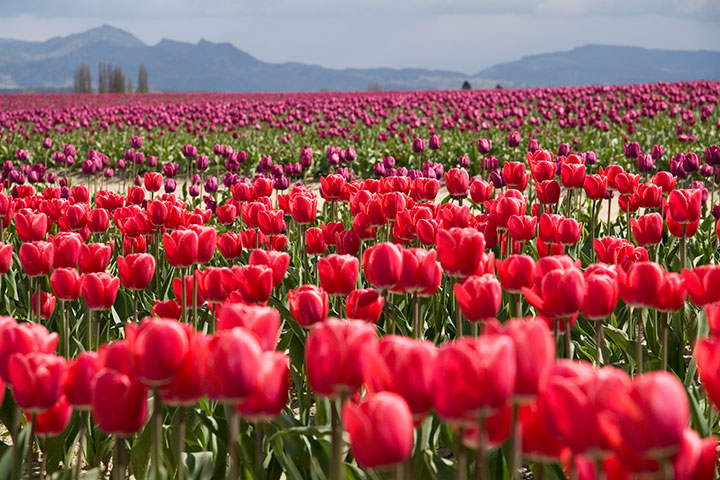
Long before we moved here, I’d heard stories of the Skagit Valley Tulip Festival, of the magic of standing in a sweeping vista of rainbow blooms, seeming to end only where the Cascades began.
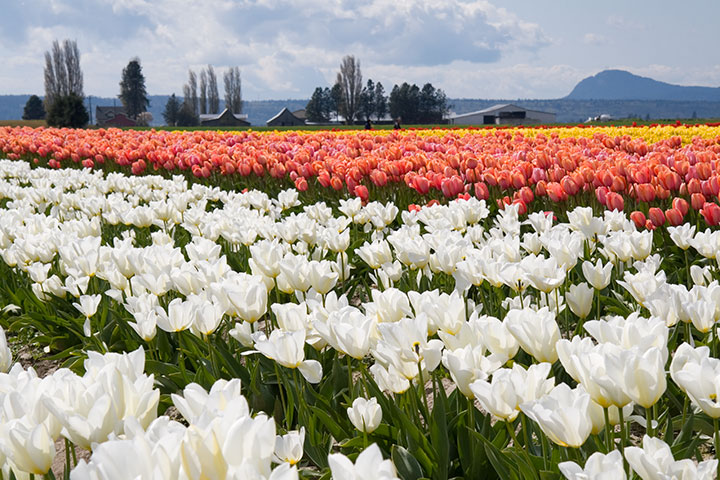
The stories left out one important point, however: the light. As soon as the sun cleared the clouds, every flower burst into a neon glow, filling the valley with unreal color.
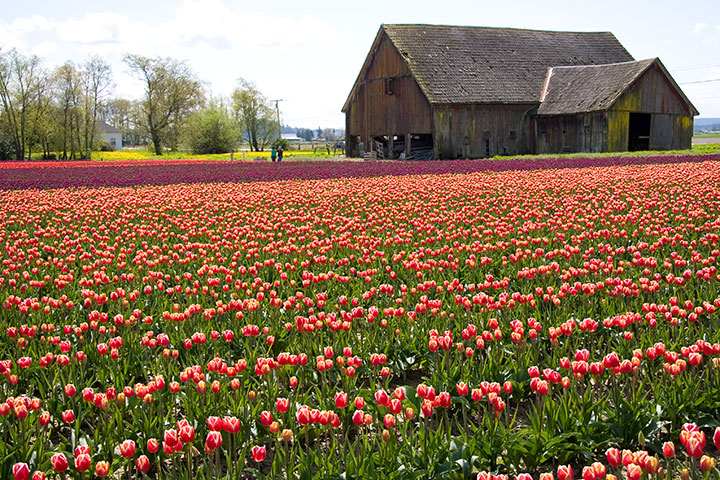
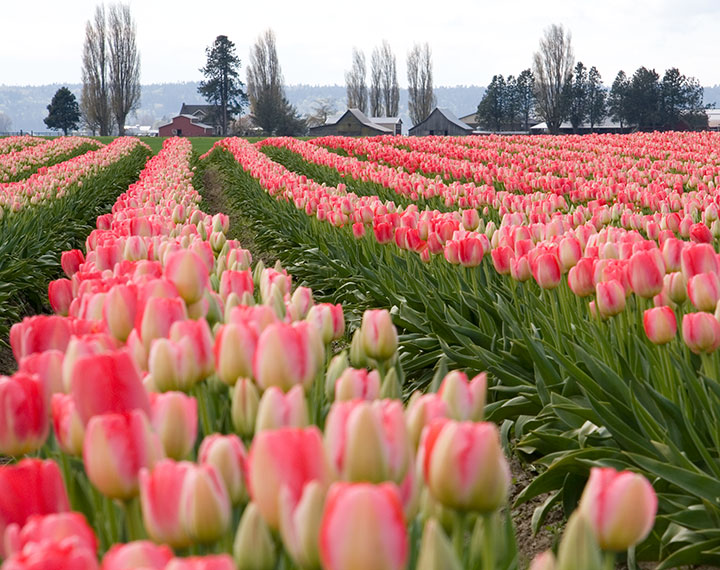
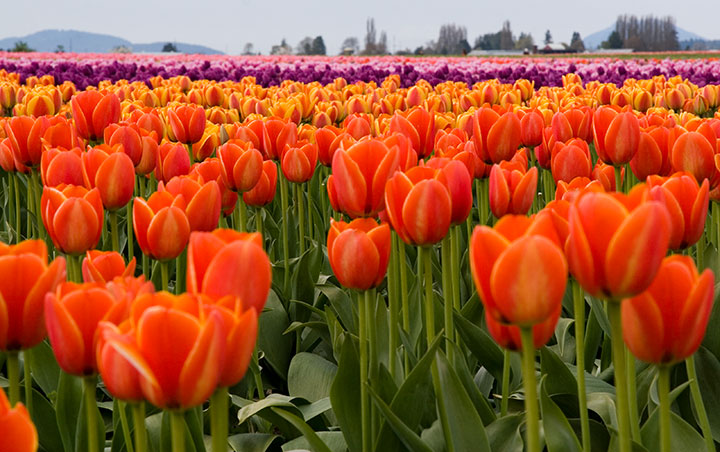
You know, for a place that claims to be grey so much of the time, my digital color correcting skills are getting awfully rusty.
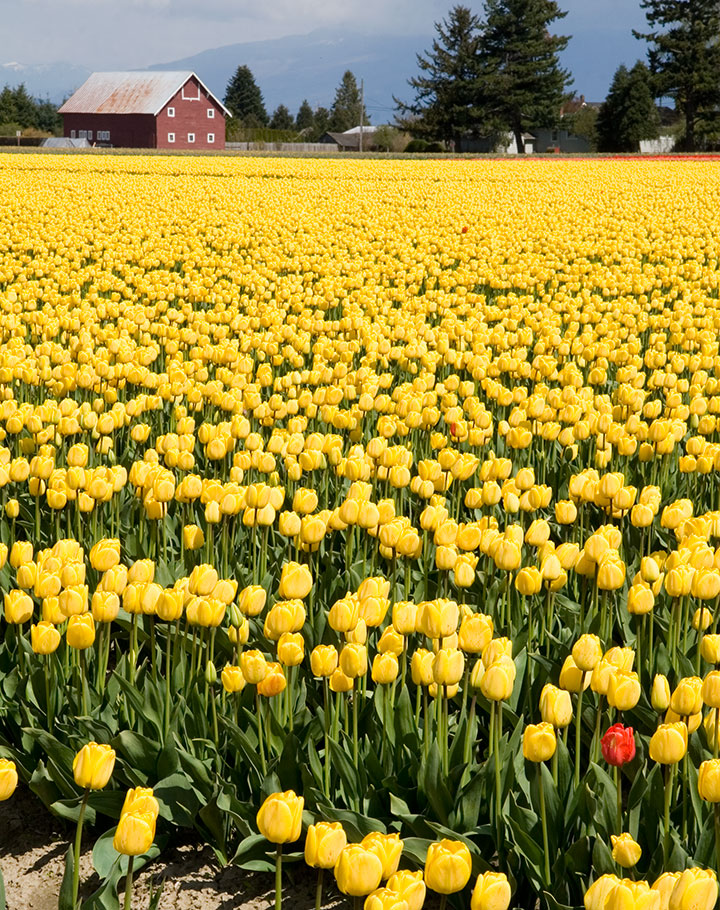
May 30th, 2009
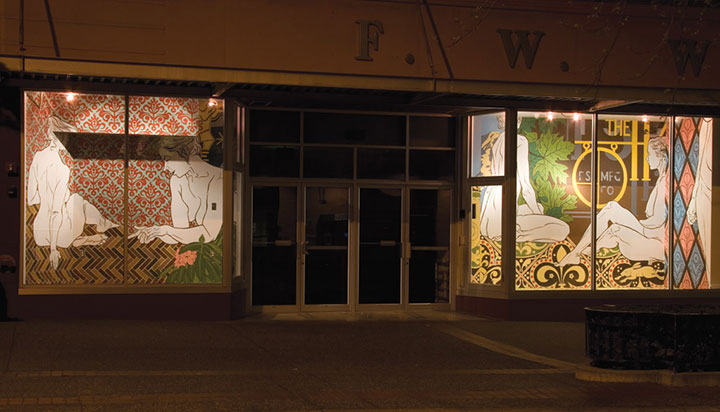
Oh, I’m probably asking for it with this post title. (To anyone who might have found this post by Googling naughty things, I’m afraid you’re about to be disappointed.)
The window displays in the old Woolworth’s store downtown have been converted into a twenty-four-hour gallery, with artist exhibitions and installations rotating quarterly. Shortly after I moved to Tacoma, I found out that they were accepting applications for the 2009 gallery slots. I thought it might be a good opportunity to try out a crazy idea I’d been playing around with, so I decided to give it a go.
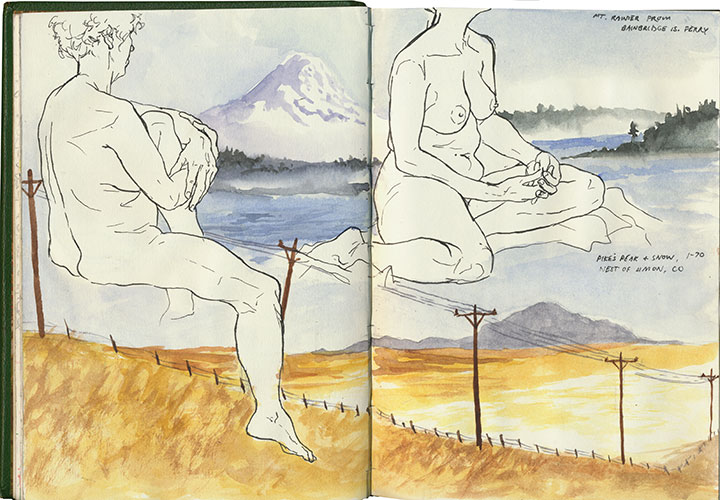
For many years I’ve carried a sketchbook everywhere I go, but for the last couple I’ve been experimenting with something a little different. One day I was in a hurry, and knew I wouldn’t have time to fill an entire spread with the watercolor sketch I wanted to make. So I chose a page that already had some figure drawings on it, and just painted within the negative space around the figures.
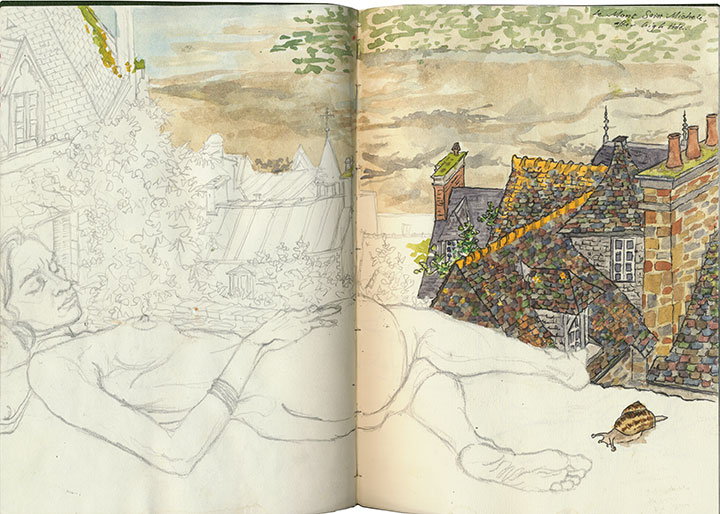
And from then on I couldn’t stop. Once the number of watercolor paintings began to catch up with my stock of line drawings, I started attending model sessions again. This time, though, I used the figure drawings to compose the page, with the expectation that eventually I’d go back in with another sketch later.
Several people told me they’d like to see these drawings on canvas or framed on a wall—and more than one suggested a wall mural version. Besides, the conceptual link between nude figure drawings and mannequins in a store windows was too tempting to resist. So I applied for a Woolworth Windows show, but I guess I never expected that my proposal would be accepted. I was talking about gigantic nudes on a busy street, after all. When the notification date came and went without a word, I assumed the project had been rejected and moved on. And then, three months later, I received an email that said, “Congratulations! By the way, your show begins next weekend.”
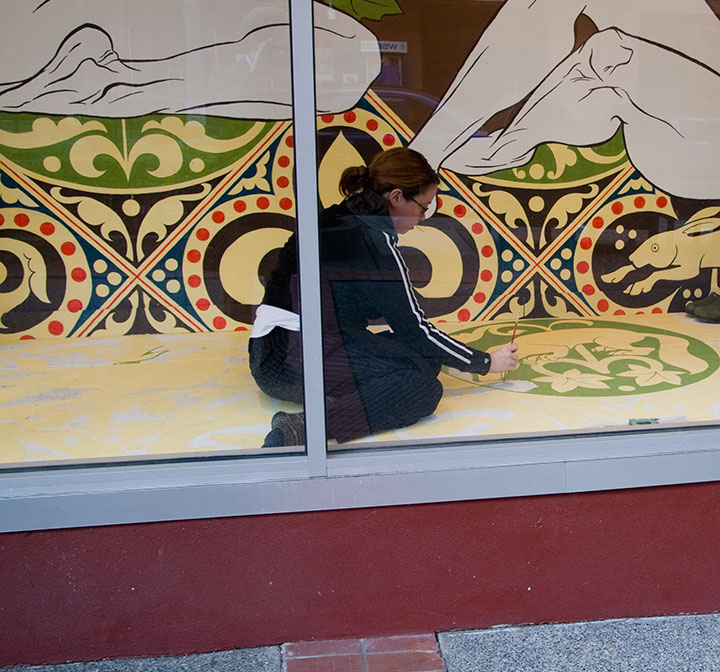
Now, I’m not normally an installation artist, but I do have six years of technical theatre and several large-scale murals under my belt. Still, there was something rather daunting about being thrown in the deep end of a double installation project, which involved attempting to paint proportionally accurate, ten-foot-tall nudes inside a narrow, very public glass box. A very monkey-cage-at-the-zoo glass box. To be fair, every mural I’ve ever painted has begun with a ripple of fear, and thoughts ranging from “Oh, right, I forgot how big walls are,” to “For the love of Pete, how did I ever convince these people that I was capable of painting something that actual humans would be able to see?” Depending on the scale of the project, of course—hey, if blank pages can be intimidating, blank walls (and tall ladders) are pretty terrifying. So this time, what with the many passers-by glancing in at me, I needed a few extra deep breaths. It’s funny that I still get that little moment of panic—because once I finally start in with either pencil or brush, I feel right at home, and even the ladder becomes an old friend. There’s just something so satisfying about slathering paint on a wall.
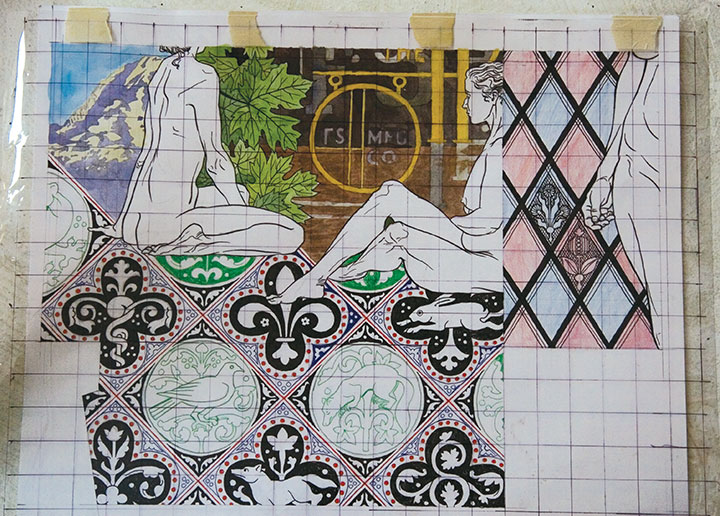
One of the challenges of the Woolworth Windows was getting my design up on the wall, at the correct size, without distorting anything. If I were painting a scenic flat for the theatre, I’d just photocopy my design onto a transparency, hook up a projector, and blow up the drawing to whatever size I needed. In a window display, however, there simply isn’t room to put a projecter far enough away from the wall. So I did it the old fashioned way: made my rendering to scale, laid a grid over it, and drew the same grid at the larger size on the wall.
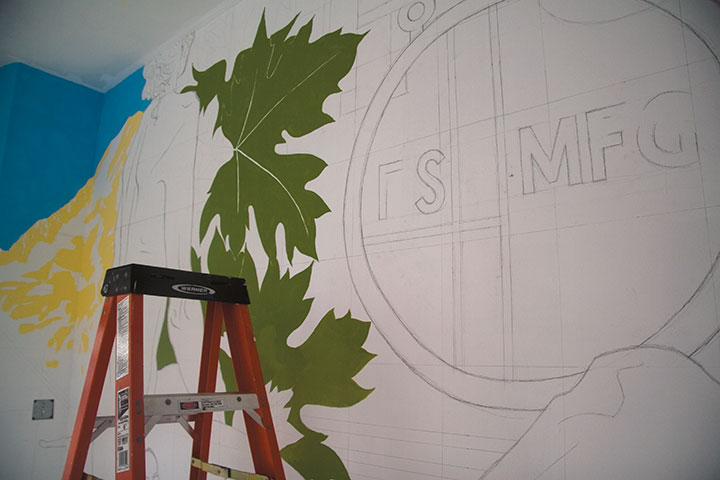
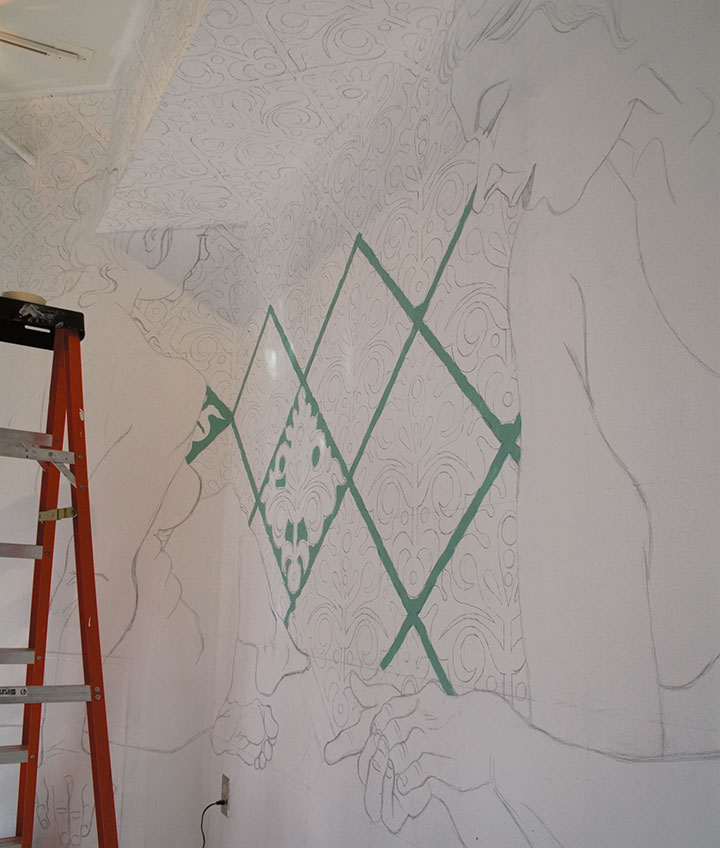
You can see a little of the pencil grid in the top photo; in the left-hand window the pattern repeats did most of the work for me.
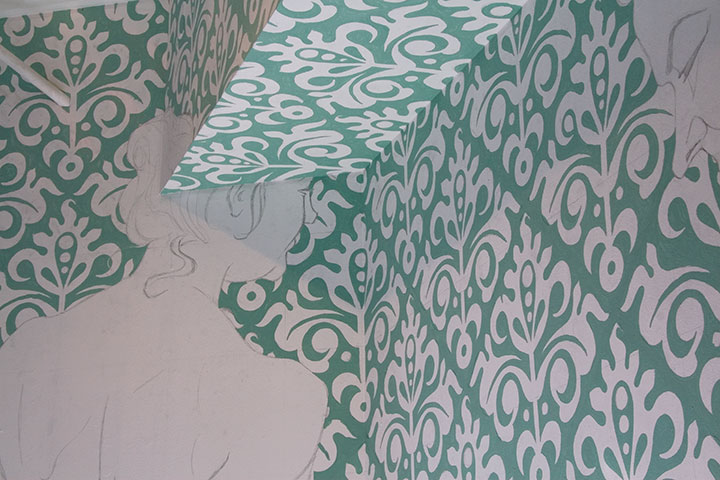
Like the drawings in my sketchbook, the inspiration came from a variety of sources. This pattern was an original design, but I was heavily influenced by the patterned brocades I saw at Versailles (see below).
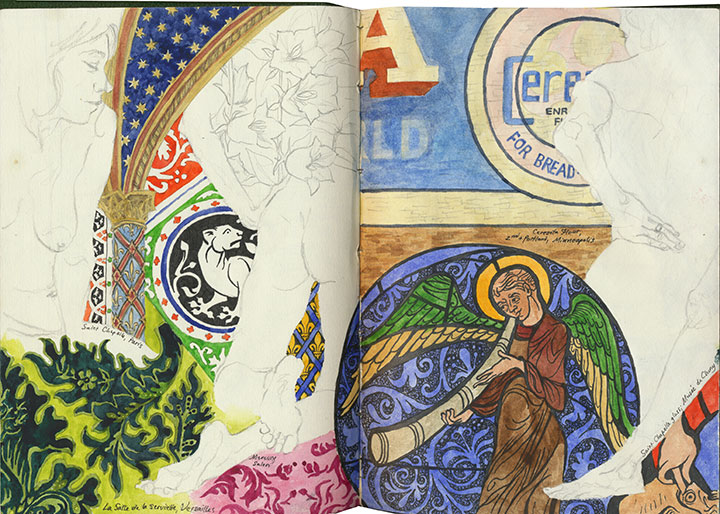
Another element from this sketchbook page found their way into the design—my drawings of the inlaid floor of Saint Chapelle in Paris became the basis for the floor of the right-hand window.
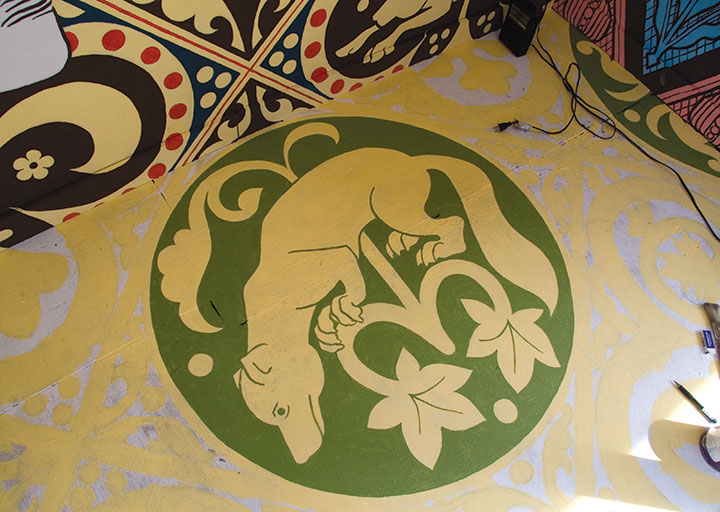
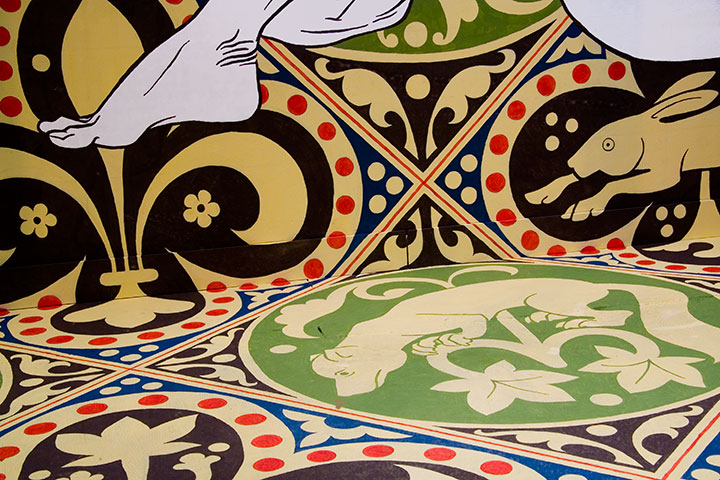
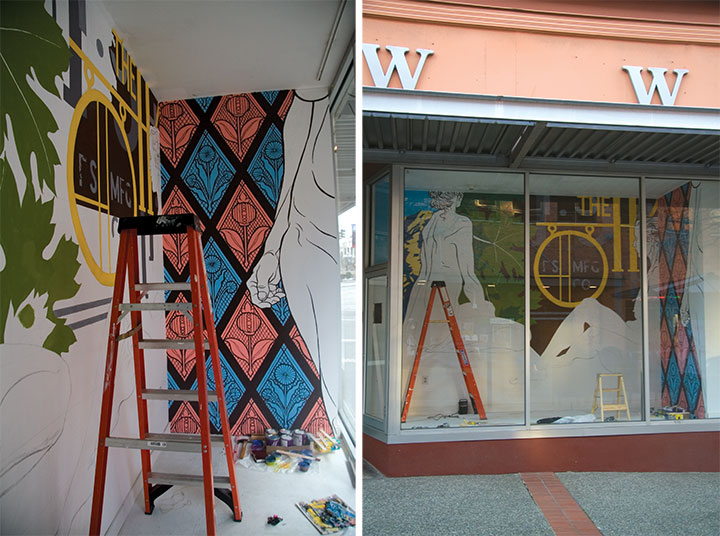
The windows also contain elements found closer to home: bits of historic Tacoma signage,
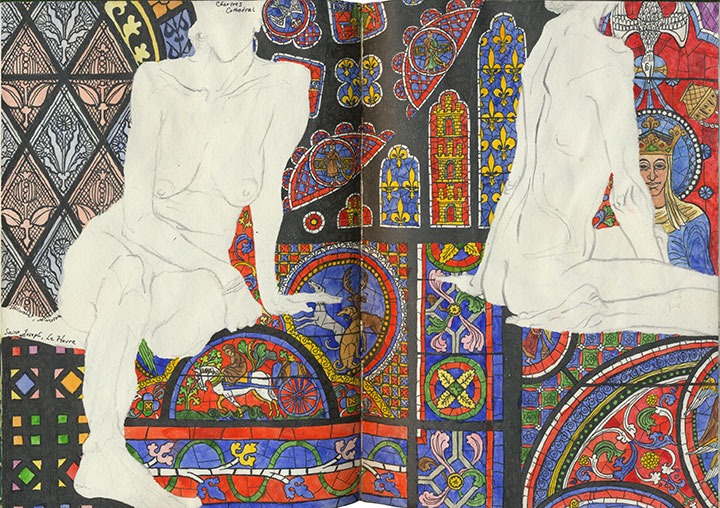
and a stained-glass window in the home of my friend Christina, who lives in a former church.
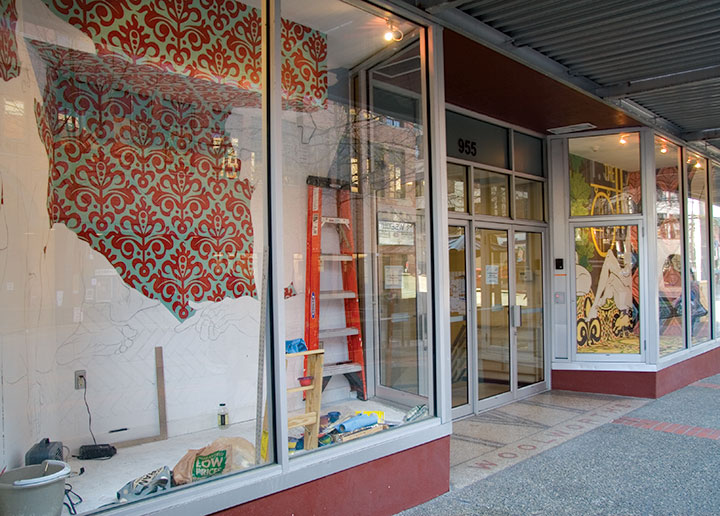
Since I had a lot of equipment to stash in such a small space, I had to paint in a piecemeal fashion,
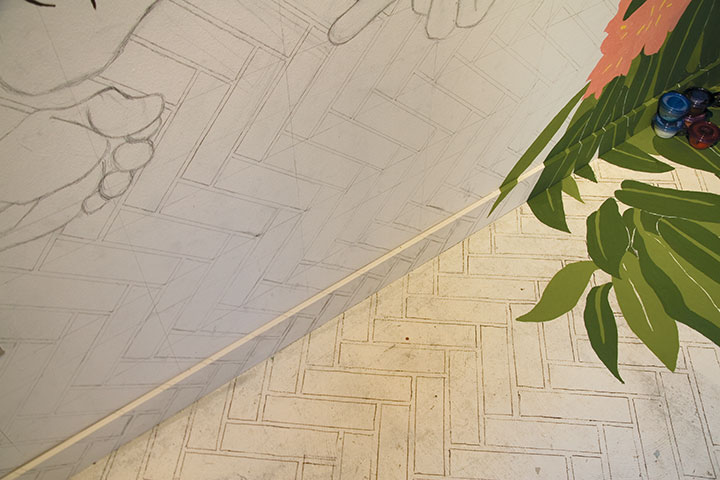
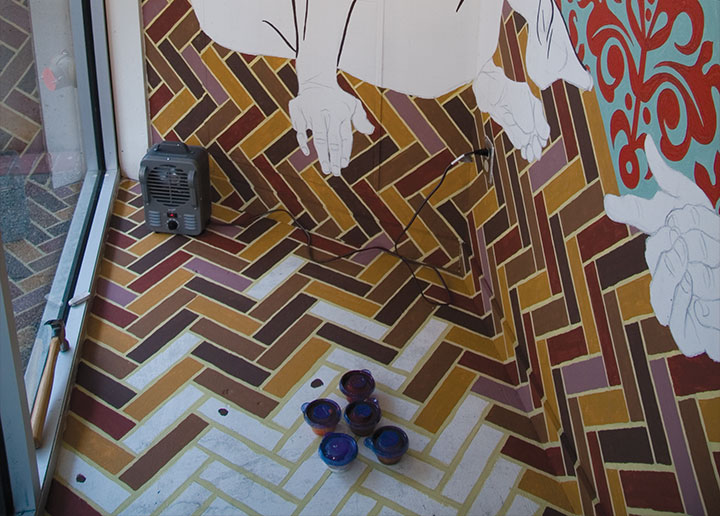
moving my supplies closer to the door as I painted myself into a corner.
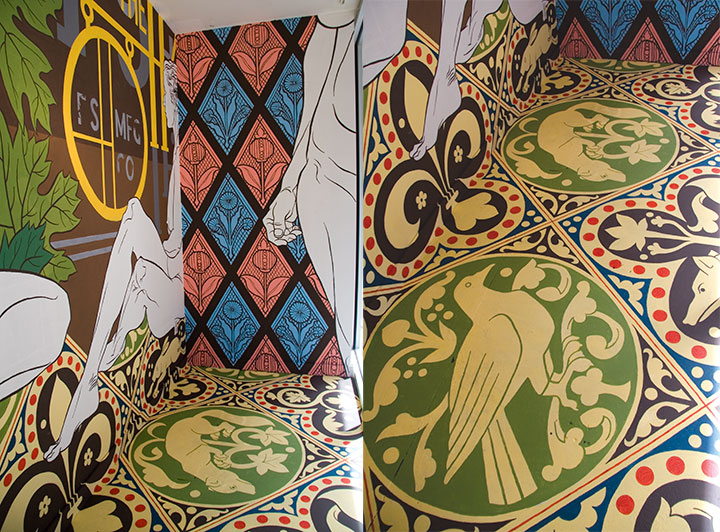
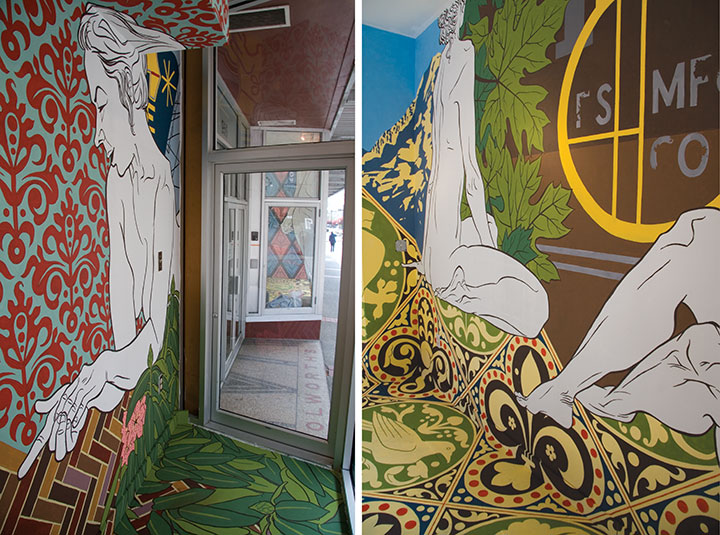
Despite the challenges of the installation, this has been one of the most interesting and fun mural projects I’ve ever done. For one thing, I fulfilled a secret childhood wish to be “one of those people” who designed and created window displays (I was a big fan of Mannequin). For another, the best part about painting in public is that you get to meet all kinds of wonderful people. Everyone I’ve seen has been incredibly supportive, curious, and thoughtful. Mothers wheeled their strollers right up to the window so their toddlers could press up against the glass and watch. School kids on a field trip gathered around my rendering and recognized the Harmon sign immediately. Street-smart teenagers stopped to ask insightful and challenging questions about gender roles in art. Friends brought me coffee on a chilly day, or kept me company when I started to get tired. Business people flashed me a thumbs-up on their way to work, and neighborhood regulars shouted their encouragement through the glass. I guess I didn’t have to worry about the public reaction to a bunch of naked ladies after all.
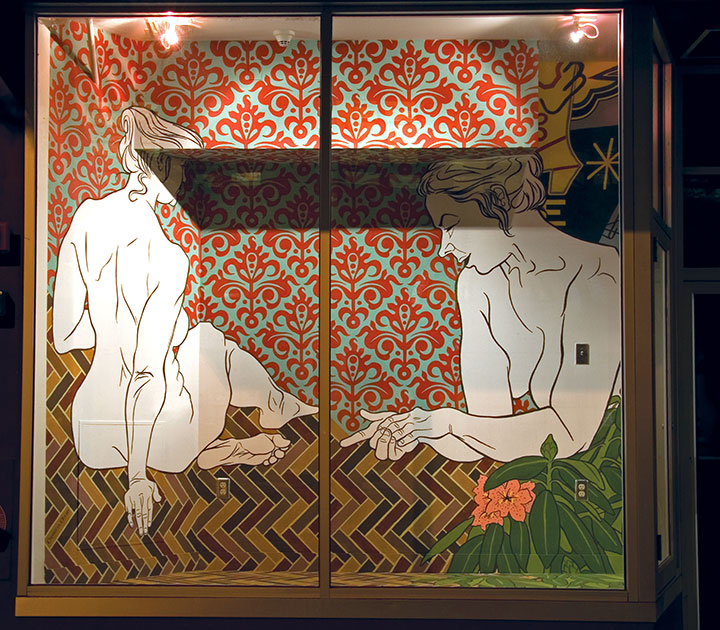
There’s a catch to all of this, however: the installation is temporary. The last day of my show is June 13, and then I have to paint everything white once more. So stop by while you can—you’ll find these ladies on Broadway, close to the corner of South Eleventh Street (on the same block as the Thursday farmer’s market).
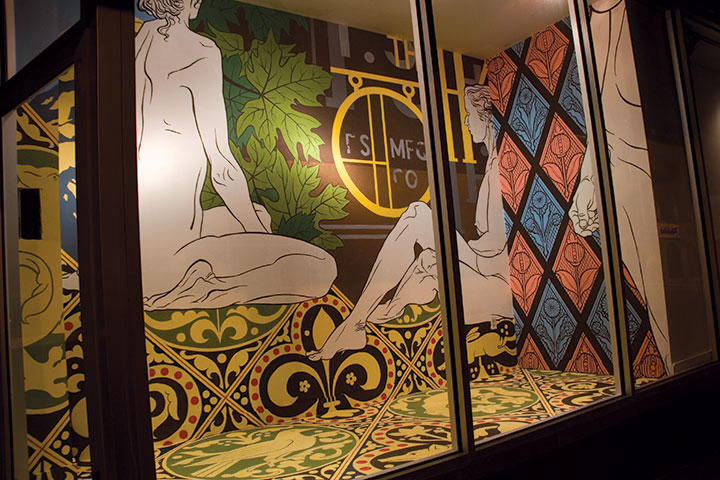
I guess that’s another thing all those years of theatre taught me: how to practice a little detachment when you have to dismantle what you built.
Even if it were only up for a day, though, it would have been worth it.
May 19th, 2009
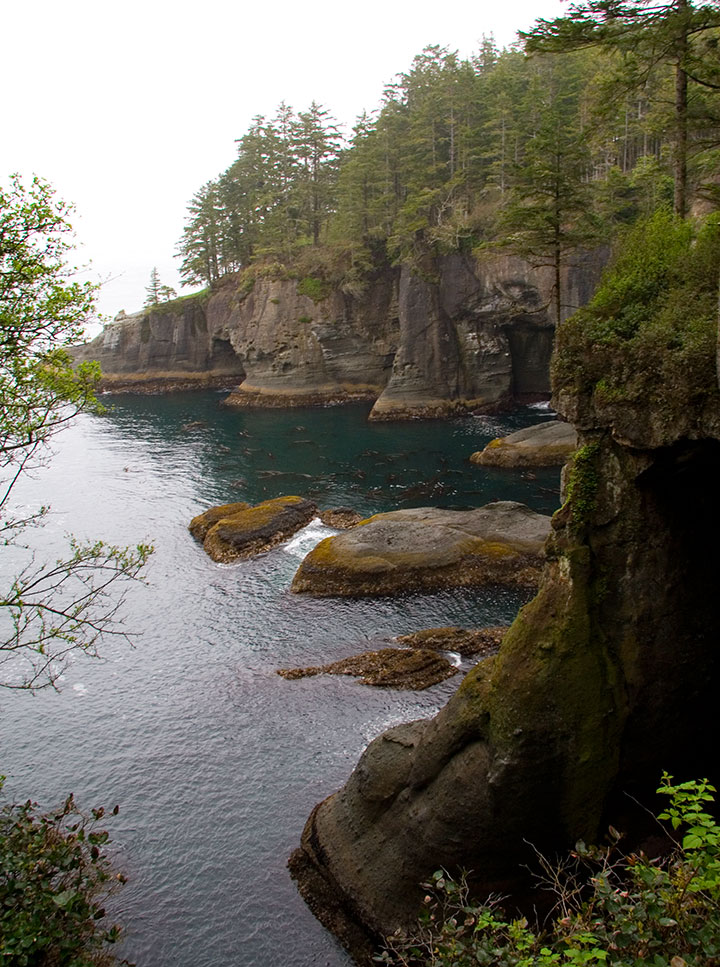
Item number 4,732 from the Bucket List:

Hike to the very tippity-tip of Cape Flattery, the northwesternmost point of the continental United States.
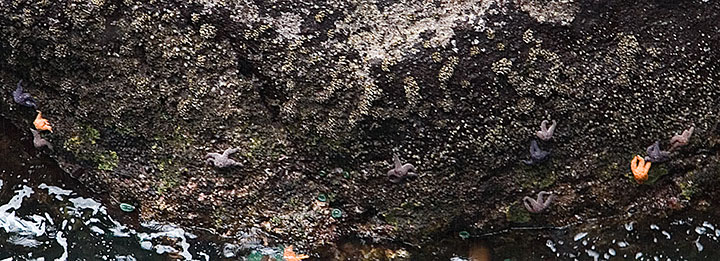
Stand leaning into the wind and rain, back to the trees, discovering how sea stars and cormorants spend their Mondays.

Gaze out to open sea with the spray crashing in your ears, erosion and subduction shaping the world beneath your very feet.
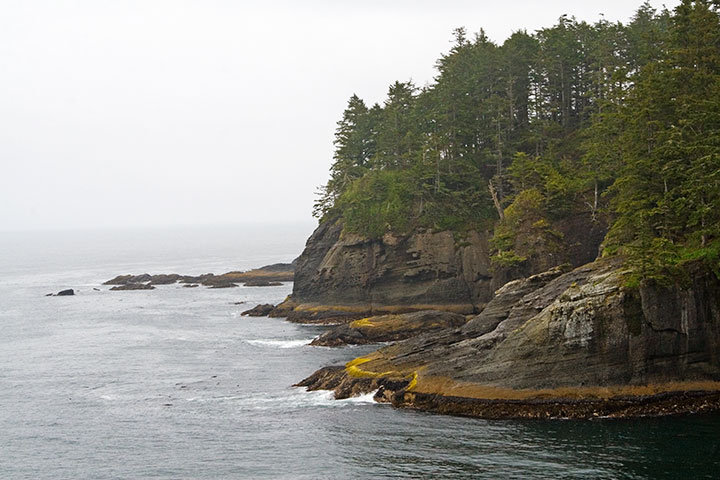
And marvel at all three thousand land-mass miles extending behind you.
Check.
May 16th, 2009
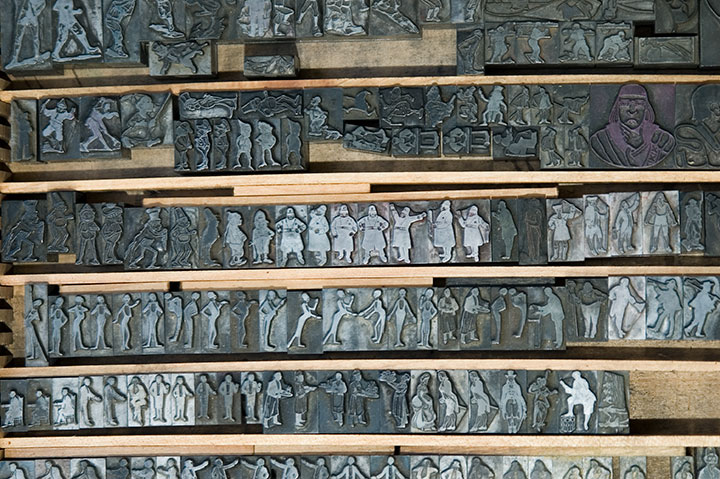
When it comes to letterpress printing, process is everything. And since that process is not always evident in the final product, I thought I’d share the technical aspects of the Dead Feminists series. Now, as I said in the last post, letterpress printing is traditionally done using metal or wooden type—or in the case of the photo above, relief images cut into type-high (.918 inches in the US and UK, in case you wondered) blocks. What Jessica and I have been doing, however, ain’t your grandpa’s letterpress. Thanks to a fairly new technology called photopolymer, we’re able to create our own relief plates right in the studio, without having to carve a block by hand or etch a plate with nasty chemicals. Photopolymer has also created a bridge between the traditional print shop and the modern digital world—as you’ll see in a moment. As far as the Dead Feminists go, Jessica and I still have both feet firmly planted in the traditional world—we just dip a toe into the digital realm now and again. Here, let me explain.
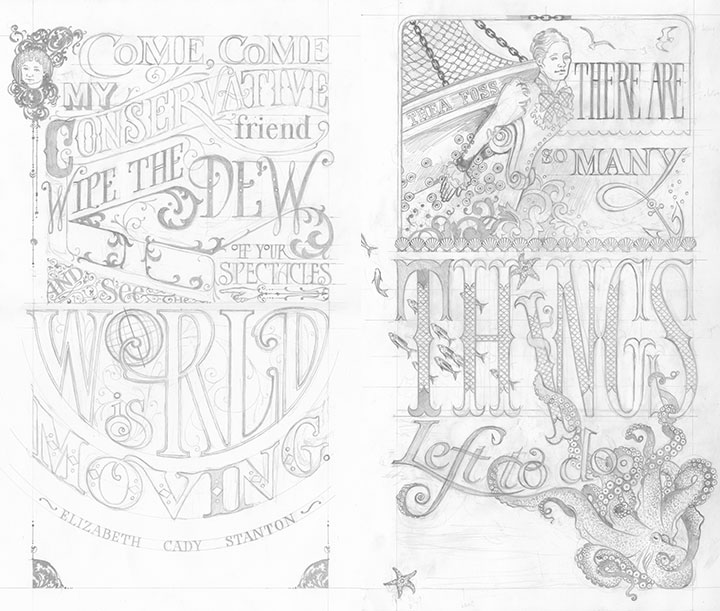
This is how it begins for each print: a pencil drawing, at full size. This is the stage where I not only design and illustrate the piece, but also start thinking about color choices: what the colors will be, what element will be which color, where the colors will overlap, how to make things work logistically. Now, this pencil layout isn’t enough to make a plate; for the photopolymer process to work properly, I have to translate the sketch into a solid black-and-white ink drawing.
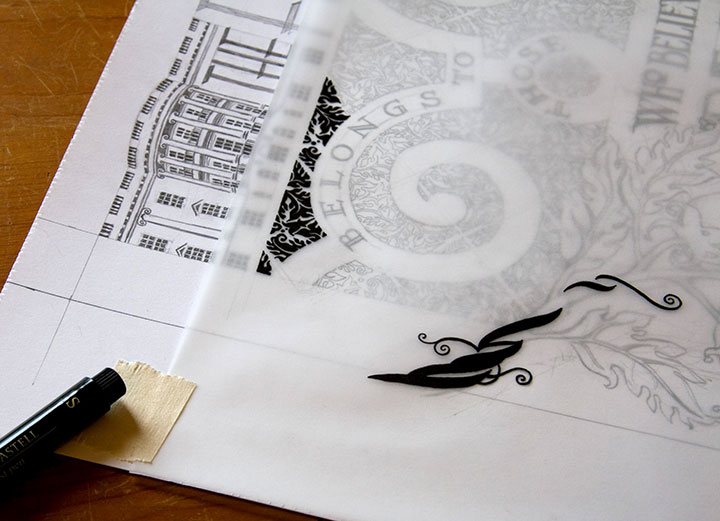
After everything is pencilled in, I lay a sheet of vellum over the drawing and trace everything in ink.
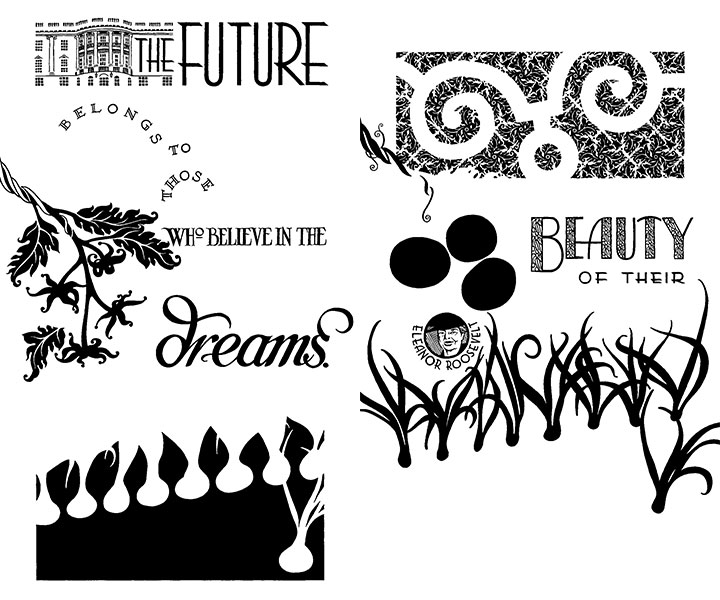
Since each broadside is printed in two colors, each color means a separate run through the press. So as a result, I had to trace each color separately—being careful to stay as true as possible to the original drawing, since the colors had to line up exactly on press. If you were to line these two color separations up, on top of one another, you’d see how the colors will interact in the final piece.
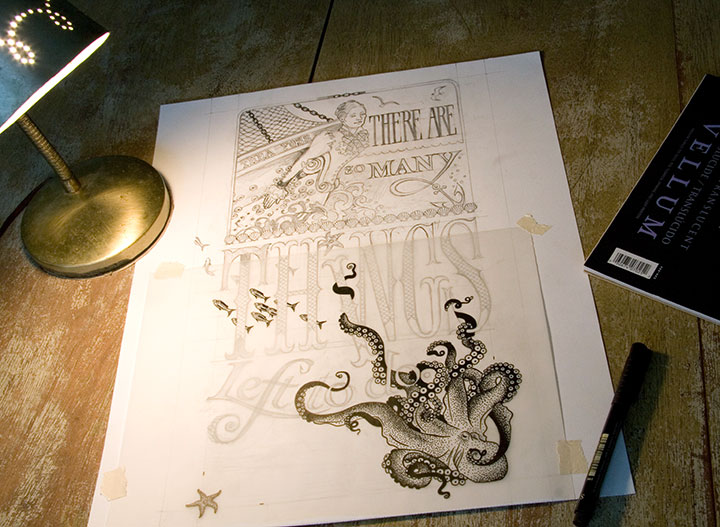
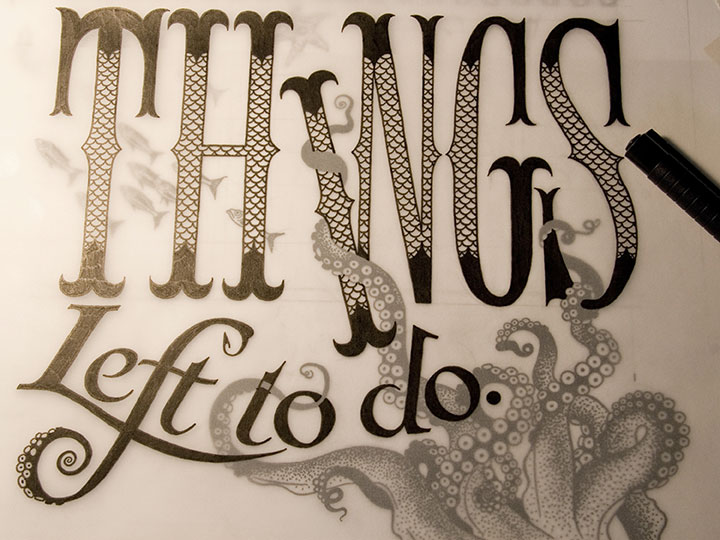
Here’s what I mean. You can see the separation that will become the grey color in Tugboat Thea here, laid directly over the inked octopus below. This is definitely the old-fashioned way of doing things; there are plenty of digital methods of color separation. I guess I just prefer the physical connection between the pen and the hand—even despite the greater risk of screw-ups (as you can see if you look closely at the word “to” above).
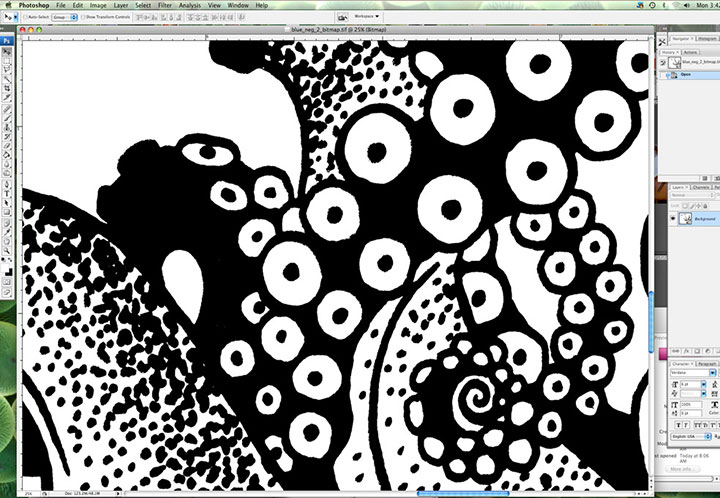
Here’s where I dip that toe into digital waters. Once I’m finished inking, I scan the finished line drawings at a super-high resolution and load them into Photoshop. This is where I clean up any mistakes (ahem) and convert the drawings into bitmap (pure black and white, with no grey) files. Jessica sends me her written colophon, and I set the text digitally. Then I export everything to the proper file type, and send the files to a local service bureau to have film negatives made. So now we’ve gone from analog to digital and back again.
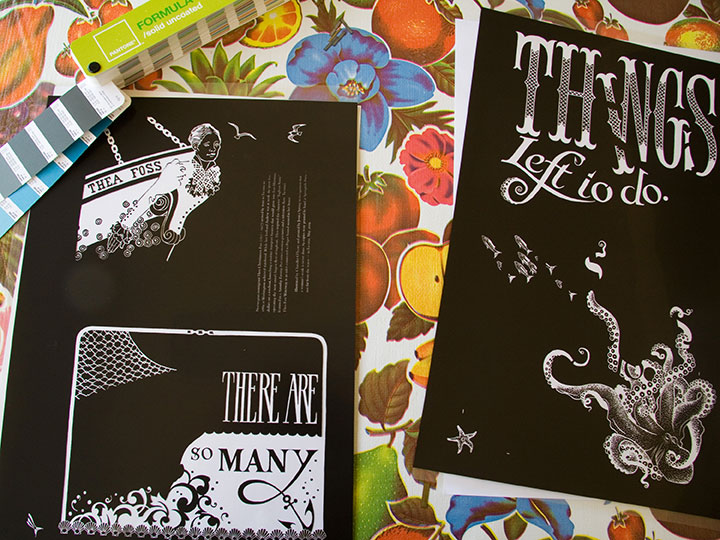
Here are the negatives for Tugboat Thea; grey separation on the top half of each one, teal on the bottom. As you can see, there aren’t any right angles in the bottom half (octopus) of the teal separation, so if you look closely you can see the little tick marks I added (above and to the right of the starfish) to aid with color registration. Those marks line up with a grid etched on the metal base we use to lock up the plates on press; once we had the plates exactly where we wanted them, I simply shaved those little tick marks off with an Xacto knife, so they’d no longer print. Real slick.
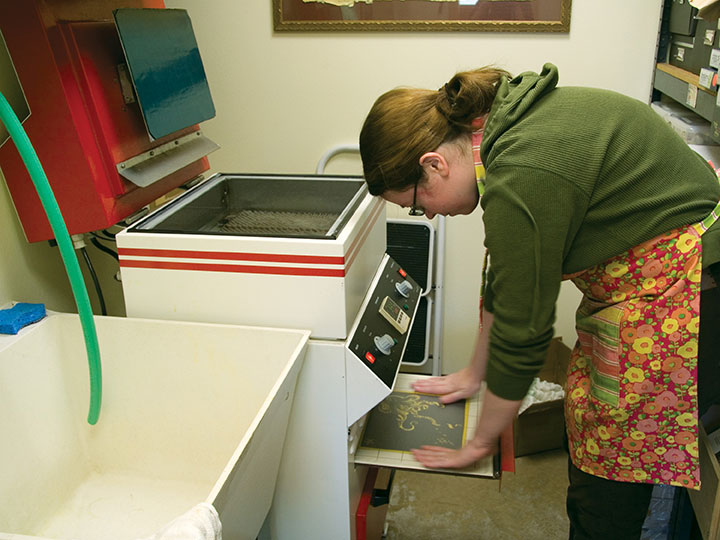
Anyway, photopolymer is a light-sensitive plastic that works just like making a contact exposure in a darkroom does. First I take a negative, place it face-down on an unexposed plate, and load both pieces onto the exposure tray of Jessica’s platemaker (which looks remarkably like an Easy-Bake Oven).
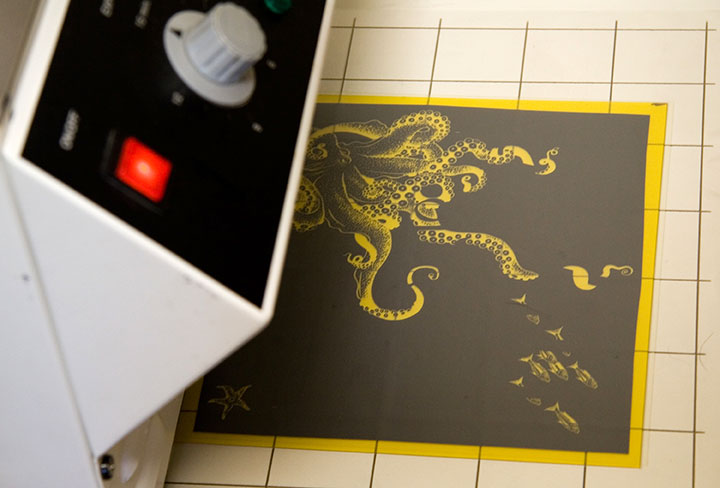
The negative is held flush with the plate by a layer of plastic and a vacuum system; the plate is exposed with UV light (some DIY enthusiasts also accomplish this using glass and a bright, sunny day, but photopolymer is awfully expensive to use in sketchy experiments in the cloudy Northwest).
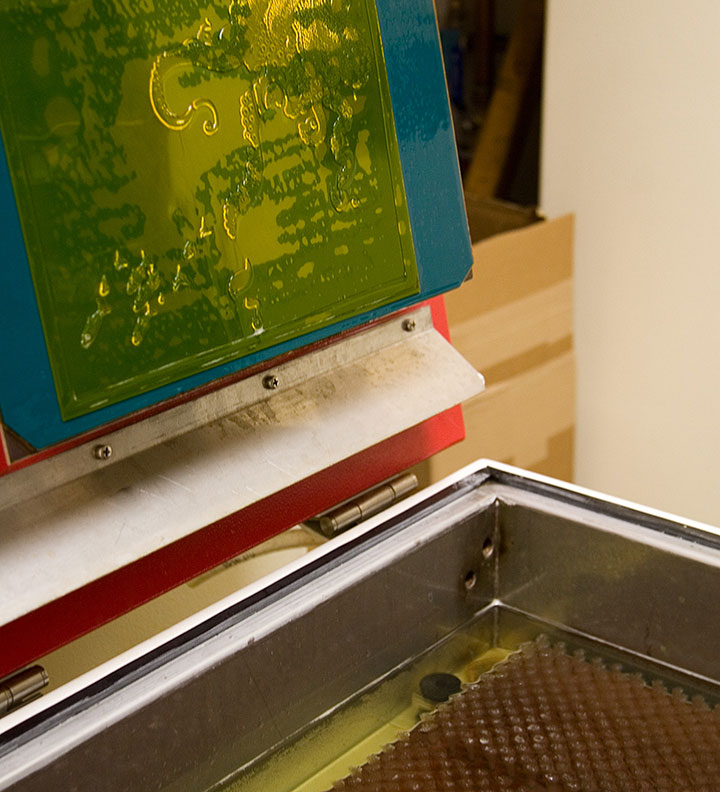
Next I place the exposed plate in the wash-out unit, where it is scrubbed gently with soft bristle brushes in a tank of cool water. Everything that is exposed is hardened enough to resist scrubbing, while everything else dissolves away. (And turns the water a sickly shade of yellow. Mmmm….plastic byproducts. Still, it’s less toxic than many other printmaking techniques.)
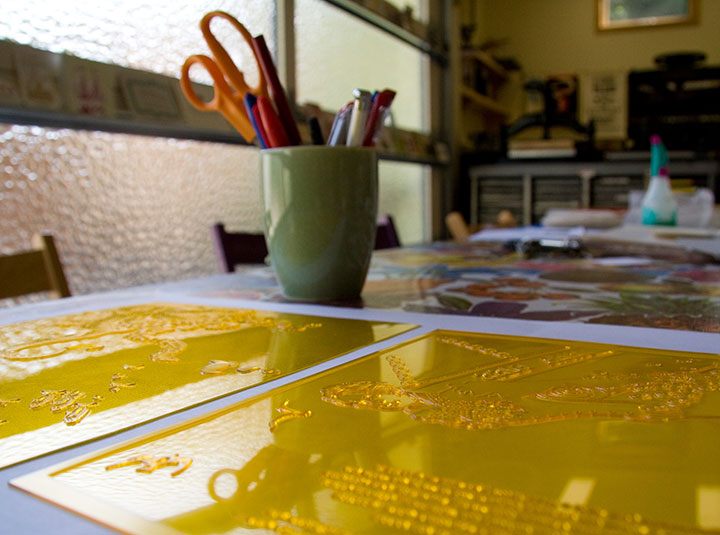
What we’re left with is a raised plate ideal for relief printing. The real benefit of photopolymer is that it can reproduce nearly any image, and can hold an incredible amount of detail. I can transfer my drawings directly to the plate, without adding the laborious step of carving the image into wood or linoleum (backwards!), or etching copper with acid, for example. It’s not exactly an economical option for letterpress printing, but the results can be exquisite, and the possibilities are nearly endless.
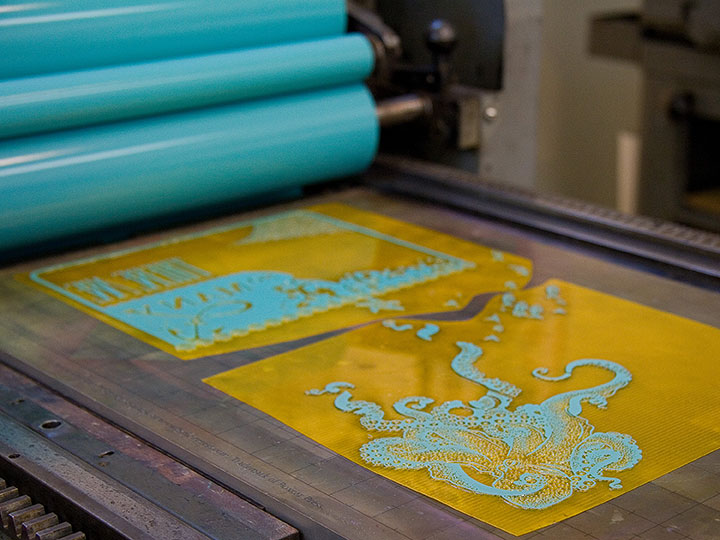
Here’s our new octopus plate on press, all inked up and ready to print—it’s stuck to that gridded base with removable adhesive. The thickness of the plate and base together add up to exactly .918 inches. Ah, precision feels good.
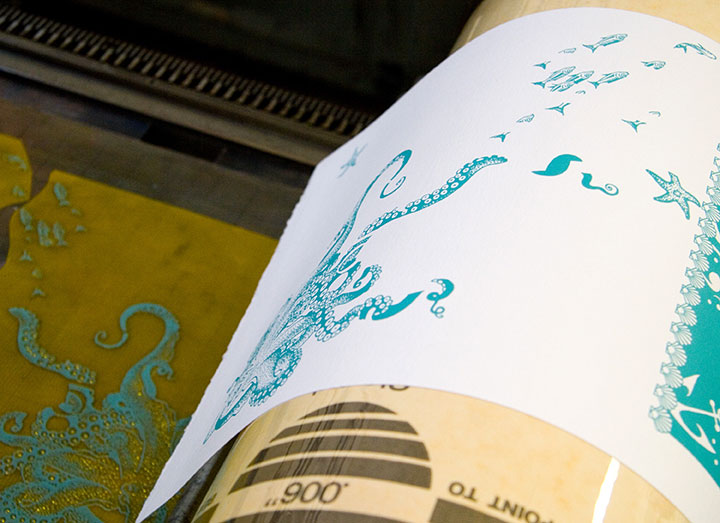
And here’s how it looks on paper.

Here you can see the registration between the colors. This is the hard part—I’m sure that despite my best separation efforts and useful tick marks, Jessica is ready to tear her hair out whenever she sees what insane registration issues I’ve thrown at her this time. She’s not a master printer for nothing, though—tiny, 9-point colophon type? No problem! Large, solid color blocks? Bring ’em on! Exacting registration with no margin of error? Sigh. Just get those plates locked up, will you?
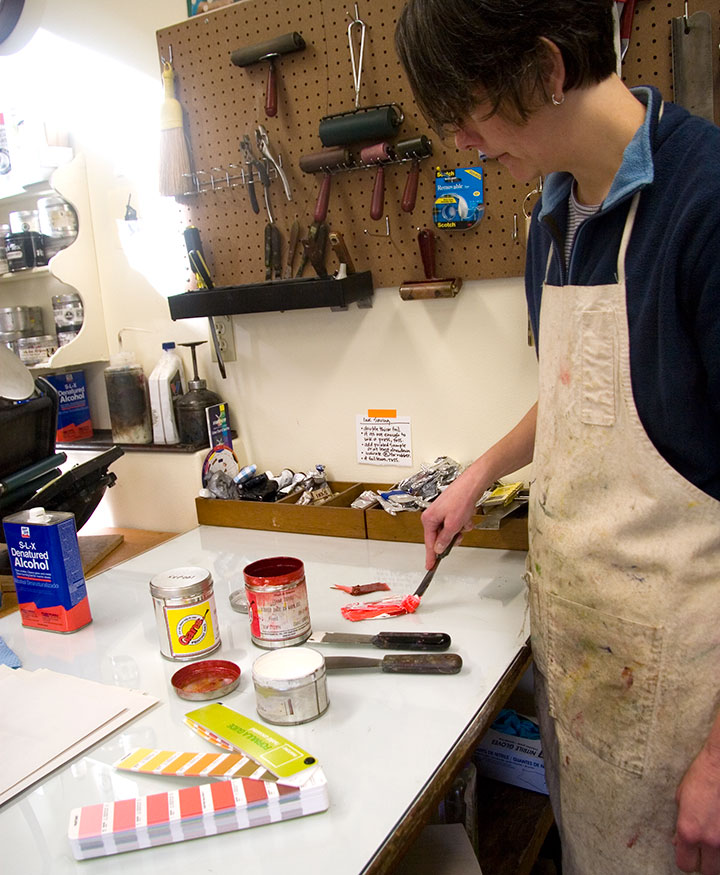
Actually printing these broadsides is where all our careful planning and preparation goes right out the window. We can sketch and plot as much as we like, but many of our artistic decisions end up being made on the fly, right on press. Here Jessica is mixing ink for Prop Cake, according to some choices I suggested in our handy-dandy color recipe book.
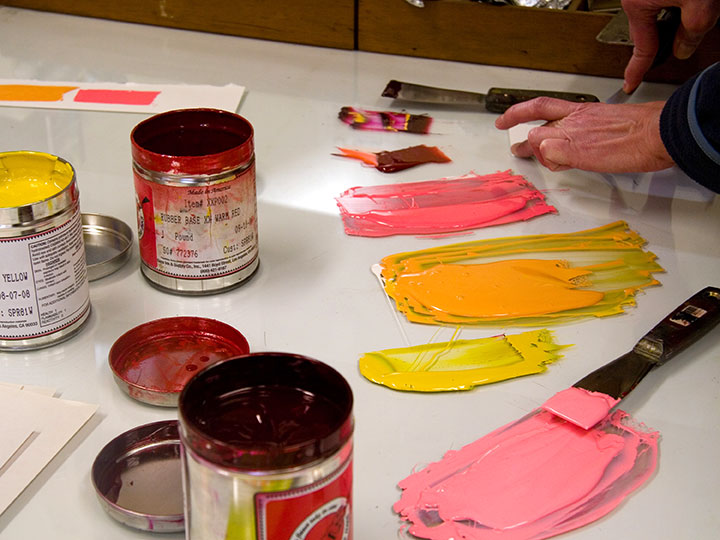
You can see our original draw-down (color test) in the upper left corner. So far, so good.
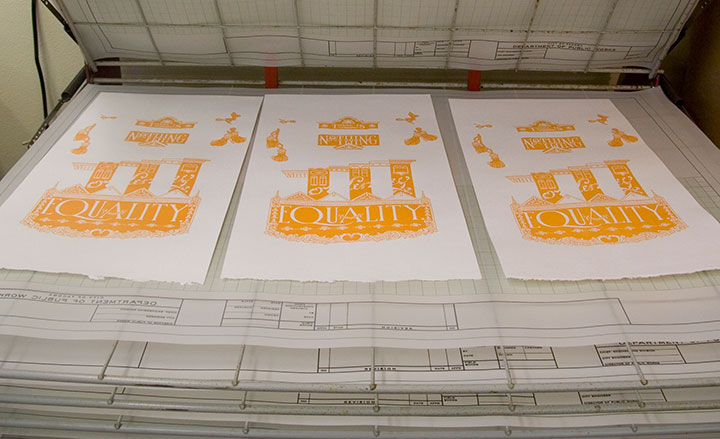
The orange turned out exactly as we’d hoped, but when we started printing the pink separation, we hated the result. What looked so good in the draw-down lost all its contrast in the print. It was awful, trust me.

So Jessica changed the color right on press, until we were happy with it.
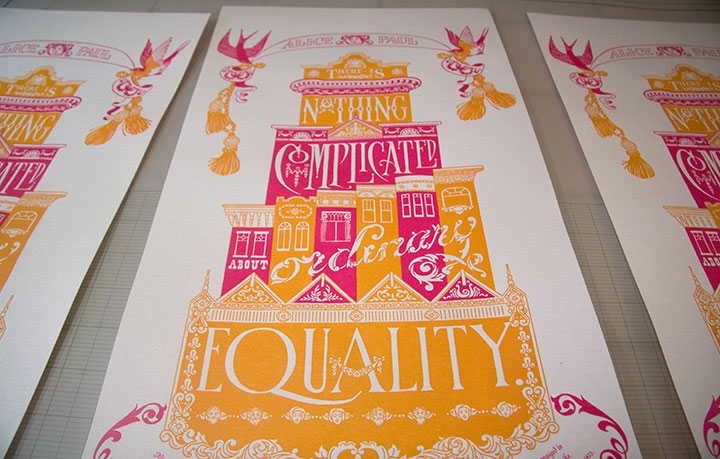
Here’s the finished product, all lined up in the drying rack.
If lining up the color areas is the hardest part of printing, keeping an eye on the ink consistency was probably the most fiddly. We’re using a very unusual paper for the series—one made from recycled clothing—that is extremely “thirsty.” Not only are there inconsistencies in the paper that can throw off the overall quality of color; but we had to add ink to the press after every fourth or fifth print. As you can see, this is a pretty organic process—lots of variables, small corrections and compromises along the way. (And a whole lot of cursing and starting over.)
All of this is par for the course for a letterpress project—it’s an exacting, sometimes frustrating process, but that’s what I love about it. And the finished product … well, it’s like nothing else. Ah, letterpress, how I love thee.
Now if only it didn’t require several metric tons worth of equipment…
May 14th, 2009
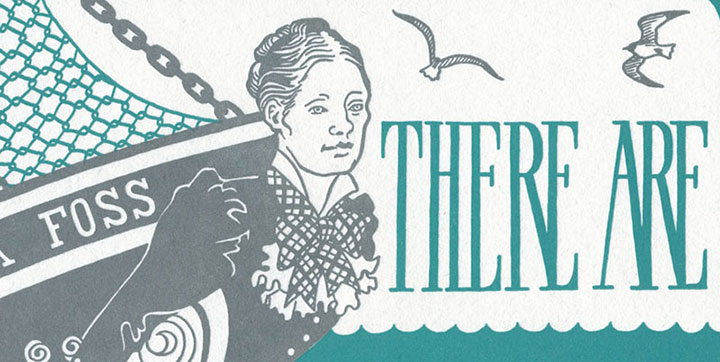
Holy cannoli, everyone! I’ve only just now come up for air—I’ve been buried under invoices, subscription forms, kraft mailers, and email print-outs, and Thea’s face is repeated all around me as reserved copies are spread all over the studio. Since I posted her here on Tuesday night the orders have just poured in, and over three-quarters of the edition is spoken for already. And Prop Cake is disappearing fast, too; we’re down to our last handful. Wow—just…wow. Thank you all so, so much.
Since Thea and her fellow Dead Feminists have left T-Town to be shipped all over the country (and to lovely Canada, France, Switzerland and the UK, too!), I thought it appropriate to share some of the things Jessica and I talked about at TAM the other day with a wider audience. Now, normally my paralyzing fear slight nervousness while speaking to a crowd manifests itself by wiping my memory clean immediately after I give a talk. It’s a very annoying thing, not being able to remember what you just said, but it happens all the time. I guess I’m fortunate that my phobias don’t show up as a quavering voice or profuse sweating (so nobody ever believes me when I say I get stage fright), but selective amnesia isn’t much of a fair trade for fake confidence! But this time, weirdly, it didn’t happen—I remember almost everything, and I think it’s because I wasn’t alone. (Jessica, I reckon that means you’re doomed to be my speaking partner from now on!) So to make sure my memory stays put, I’m setting it down here for the record. (By the way, since there’s rather a lot to say on the subject, I’ve decided to break it into two posts.)
• • • • • • • • • • • • • • • • • • • • • • • • • • • • • • • • • • • • • • • • • • • • • • • • • • • • • • • • • • • •
Before I get into the technical details behind our series, I should probably share a little background information on letterpress and the art of the broadside. For those of you who aren’t familiar with the process, letterpress printing refers to a type of relief printing, where pressure is applied to a piece of paper placed over a raised form that is covered with a thin layer of ink. This pressure transfers the inked image onto the paper, and can be repeated to create a batch, or edition, of prints. The form can be a carved block of wood or linoleum; a raised plate made of magnesium, photopolymer (plastic) or other materials; or as the term letterpress implies, movable type made from metal or wood.

The innovation of printing words from individual letter blocks that can be rearranged and reused was actually invented by the ancient Chinese (seriously, what wasn’t originally invented in China? We owe those folks a whole heap), but the process that evolved into modern letterpress was most famously perfected over 500 years ago by Johann Gutenberg, of Gutenberg Bible fame. By the first half of the twentieth century, when more modern commercial printing came along, it was still common for printers to perfect their layouts using movable type and relief-cut images on a proof press (such as Jessica’s Vandercook below). They’d then use the resulting print to make more sophisticated plates for their more efficient and advanced commercial presses.
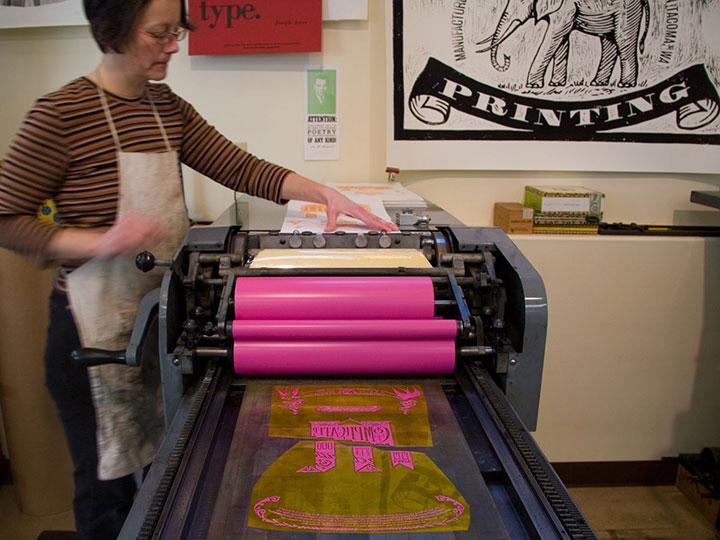
Jessica printing “Prop Cake” on her Vandercook Universal One press
As commercial printing became more streamlined, the cylinder and platen proof presses (see photo above) fell out of vogue, and eventually were no longer manufactured. Artists quickly saw their potential, however, and have adopted letterpress printing as an art form—using, refurbishing and maintaining this antique equipment to create original works of art.
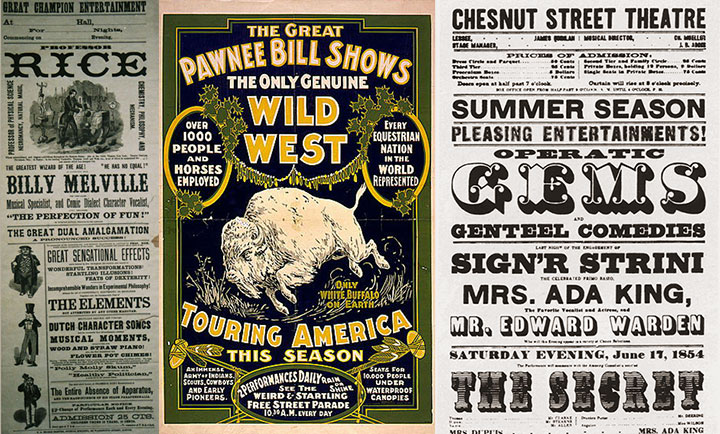
Hand-in-hand with letterpress printing, the art of the broadside has also survived and evolved into a modern format. The term broadside means any single sheet used to convey information, often of a political kind—the great-grandpappy of the modern poster. While today the words broadside and poster are sometimes used interchangeably, the broadside has remained a favorite of the letterpress community because of its emphasis on typography and content (hey, we need an excuse to use all that gorgeous metal type!).
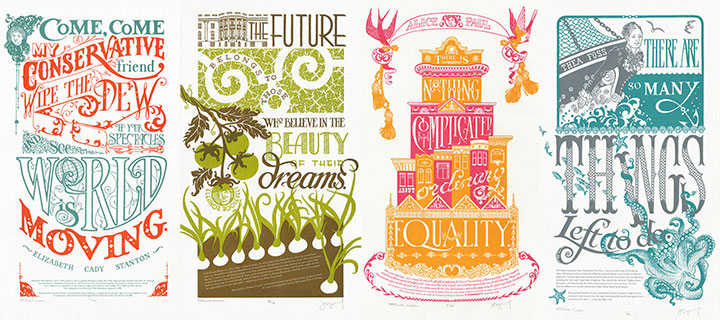
Jessica and I had this history in mind when we began the Dead Feminists series. As I said before, we never dreamed of starting down the path we’re on now; we just wanted to make a political and artistic contribution to the election. And to pay homage to the history of the broadside and the era in which each of our feminists lived, I designed each piece with historic broadsides and posters in mind. And to keep the series consistent, Jessica and I came up with a few rules of engagement:
1. Each poster has to feature a quote by a feminist. It doesn’t necessarily have to be a woman, but there are already plenty of posters highlighting the words of dudes, so we figured that one was covered already.
2. Said feminist must be deceased. (Hence the name.) You’d be surprised how many challenges that’s created for us.
3. Each quote is tied into a current sociopolitical issue or event. This is usually Jessica’s job, as she’s got a particular knack for finding relevant quotes.
4. The whole piece (except the colophon at the bottom, of course) is hand-drawn.
5. We try to stay away from well-worn tropes like “women can do anything men can do!” in favor of broader topics and concepts.
Who knows how long people will be interested in these things, or how many broadsides there’ll be in the series—all we can say is that we’re grateful for the response people have had, and we’re having way too much fun to quit now. The fun of art-making and the joy of the public response aside, the best part of creating this series has been exploring the lives and work of so many inspirational people. “Feminism” has become somewhat of a dirty word these days—mostly because of misconceptions. To us it’s a positive thing, and creating this series is our way of celebrating those who championed far more than just gender equality. Besides, we’d like to make our own contribution to our social history—and using the “power of the press” in the literal sense is the best way we know how.
• • • • • • • • • • • • • • • • • • • • • • • • • • • • • • • • • • • • • • • • • • • • • • • • • • • • • • • • • • • •
Coming in part two: the nitty gritty details behind our process.
May 12th, 2009

Well, here she be. (Or should I say, Thar she blows?)
At long last, Thea is here, barnacles and all. Jessica and I unveiled her at our Pressing Matters talk at the Tacoma Art Museum this morning. I have to say, I was nervous that with the weekday morning time slot, we’d be hoist on our own petard for the big debut. Since 10:30 on a Tuesday isn’t exactly an hour available to everybody, we were afraid we’d be lecturing a bunch of empty chairs. Boy were we wrong. Many thanks to all of you who skipped out on work, took a long (and very early) lunch, or otherwise carved out an hour of your day to spend with us—we raise our pirate flags to you. And to Allison Baer, TAM’s very own renaissance woman who made it all happen, you get the biggest Jolly Roger of them all. Thank you.
This week I’m going to post some of the things we talked about today at TAM, about the making of Tugboat Thea and our series. But for now, let’s just get down to brass tacks about the broadside. Here’s the quote that started it all:
There are so many things left to do. — Thea Foss
In honor of enterprising women everywhere, the print features business pioneer and entrepreneur Thea Foss, who founded the Foss Tugboat company in Tacoma, WA—at a time in history when it was not only courageous, but nearly unheard of for a woman to do so. Here Thea is portrayed as the figurehead of her own tugboat, surrounded by crashing waves and sea life native to her home waters of Puget Sound.
• • • • • • • • • • • • • • • • • • • • • • • • • • • • • • • • • • • • • • • • • • • • • • • • • • • • • • • • • • • •
Tugboat Thea: No. 4 in the Dead Feminists series
Edition size: 89
Poster size: 10 x 18 inches
Printed on an antique Vandercook Universal One press, on archival, 100% rag (cotton) paper. Each piece is numbered and signed by both artists.
Colophon reads:
Norwegian immigrant Thea Christiansen Foss (1857 – 1927) arrived by train to Tacoma in 1889 as Washington achieved statehood. While her husband Andrew was at work she spent five dollars on a rowboat, launching a marine transport business that would grow into Foss Maritime, operating the west coast’s largest fleet of tugboats. Thea inspired the character “Tugboat Annie” featured in a Saturday Evening Post series, motion pictures and a television show. Tacoma’s Thea Foss Waterway is an inlet connected to Puget Sound named in her honor.
UPDATE: poster is sold out. Reproduction postcards available in the Dead Feminists shop!
May 7th, 2009
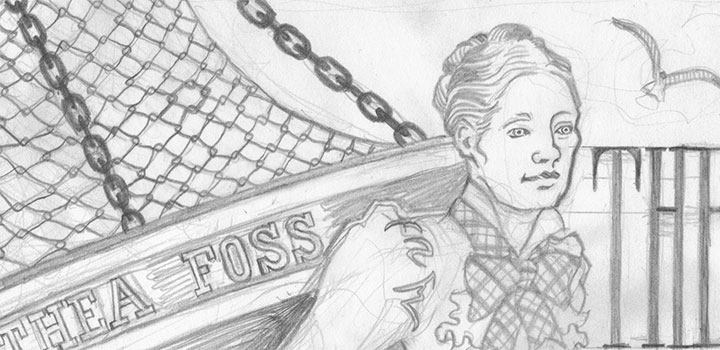
Thea’s back! This is just a sneak peek of the pencil sketch for now; Jessica and I are unveiling Ms. Foss’s new look on Tuesday, so we’re saving the surprise for then. In the meantime, though, we thought we’d offer up a few snippets.
The latest broadside in our Dead Feminists series has been a little bit of a different process, at least on my end. We had the chance to create a prototype of sorts when we were asked to make steamroller prints at the Wayzgoose this year. But while several hundred people were there to witness the steamroller in action, only eight huge Tugboat Thea prints exist—not exactly ideal in the supply-and-demand sense. By redesigning the piece, we we’d no longer be limited by what we could hand-carve out of a slab of linoleum. So we let the first Thea serve as a rough draft, and took another crack at it for the official series.
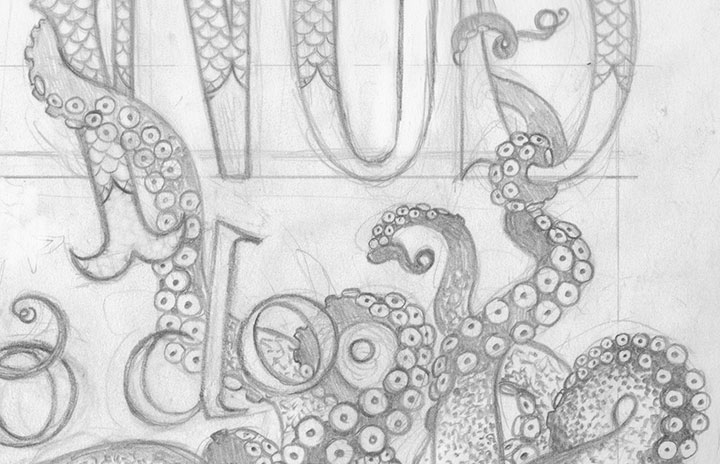
This time, though, there’s a bit of a twist. That’s all I’ll say for now.
As part of the unveiling of the new Tugboat Thea, Jessica and I will be speaking at TAM on Tuesday morning. If you’re in the area, and you can fit the weird time slot into your schedule (sorry about that), here are the details:
Pressing Matters:
Contemporary Collaborations Highlighting Women in History
Tuesday, May 12, 10:30 a.m.
Tacoma Art Museum, 1701 Pacific Ave.
Tugboat Thea will be available for sale at the event, too—look for it to appear here afterward!
April 24th, 2009
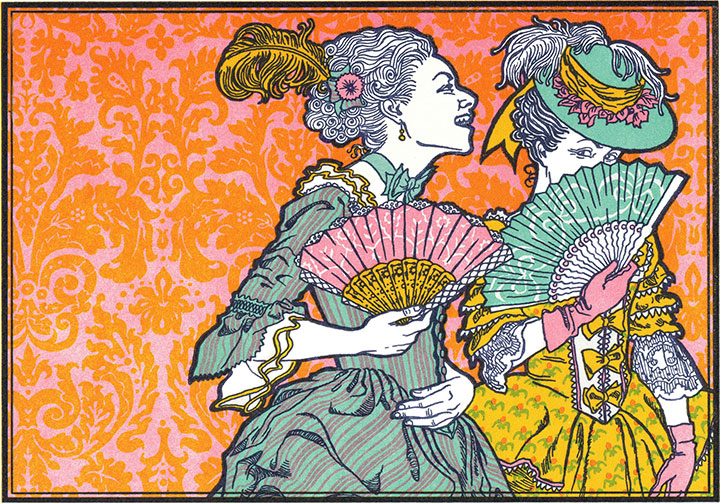
For the past eight months a stack of hand-printed postcards bearing my Versailles gals illustration has lived in the front pocket of my bag—sharing cramped quarters with my sketchbook and watercolors, ready whenever anyone asks for my business card. I’ll admit this sucker was originally designed as a promo postcard, but I kind of like the idea of a gargantuan, six-inch business card—even if you’d need a really big wallet to keep it in.
These days, the question I most often hear is “How can this be letterpress?” I’ve launched into so many long-winded explanations of the convoluted process behind this thing that sometimes I bring visual aids with me to art functions. Yes, I’m a nerd. I carry visual aids around.
Ahem. Anyway, soon I’ll be putting those visual aids to use in the classroom. If you happen to be a fellow Northwesterner, I’ll be teaching a letterpress class in Seattle next month that combines good old-fashioned line drawing with digital typography, and old-school hand printing with snazzy graphic design software.
Johann Gutenberg is probably rolling in his grave right this minute.
Hmm … well, before I get my cosmic comeuppance from the ghosts of my professional ancestors (I also know how to hand-set type, I promise!), here are the details:
Digital Design Meets Letterpress Printing
Six Mondays, May 4 – June 15, 2009, 12 – 5 p.m.
School of Visual Concepts, Seattle, WA
The class is already almost full, so hurry and claim your spot! Let’s give old Herr Gutenberg something to spin about.
April 18th, 2009
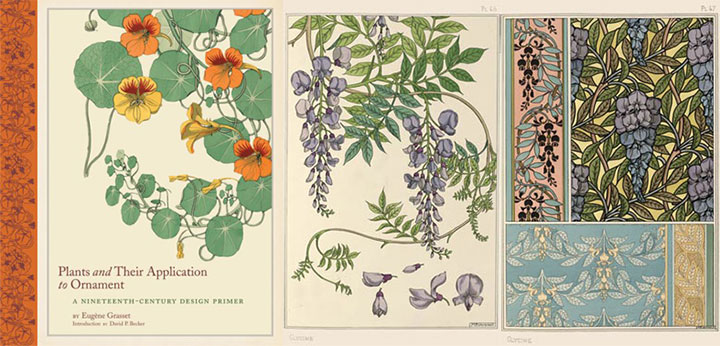
My work tends to deal heavily in flowery typography and ornamental Victorian doodads, so this book has become a constant companion. It’s a reprint of an 1897 design primer, and displays a series of increasingly abstracted renderings of various flora, from realistic illustration to graphic pattern. Most of the patterns in the book aren’t really my cup of tea, but they get the wheels turning and make me think in terms of filtering my sketches and observations into graphic elements. And since I’m in need of some new reference material, both for upcoming letterpress projects and for the new artist book I’m working on (more on that another time), I thought I’d see what spring in the Northwest had to offer. So on Thursday my friend Nicole and I took a little field trip to the Washington Park Arboretum in Seattle and strolled along Azalea Way, cameras in hand.
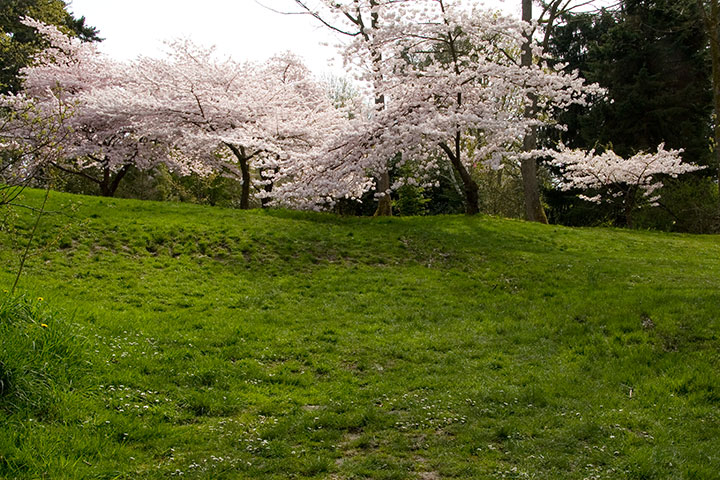
And boy howdy, those cherry trees weren’t kidding.
Everywhere I turn I hear complaints about how pokey spring has been ’round these parts, but I have to say—if this is late, I can’t even imagine what “early” means. It’s been a long, long time since I’ve lived anywhere that had blossoming trees by early April. We had a late spring in Minneapolis last year, the last spring I lived there—which meant that it was Memorial Day before the blooms had anything to say about it (I know, because I was fretting about the bare trees right up until my wedding that weekend). So I’ll take this Northwestern spring, and be very, very glad.

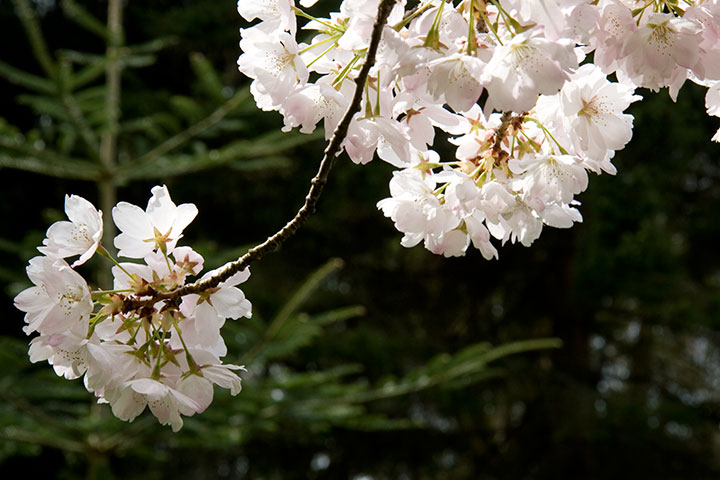
The sun decided to join us, illuminating every perfect bloom in turn.

A few magnolia varieties were ready for their close-up;

while the saucer magnolias thought they’d sit this one out. But those branches! Each tree looked exactly like a candelabra.

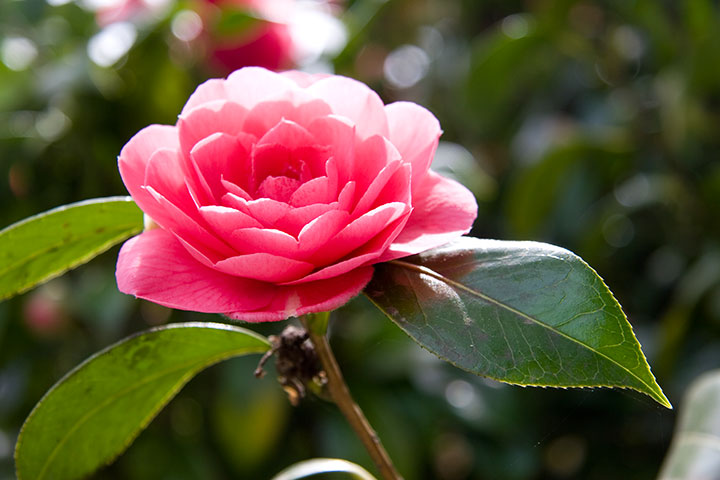
Not to be outdone by the trees, the shrubs and perennials had their say as well.

Even the greenery was super-saturated (no need for Photoshop today!).
I came away with a head full of ideas, and my work cut out for me. Nicole and I weren’t the only artists out that day, either; Azalea Way was just crawling with oil painters, watercolorists and photographers—and other like-minded folk who seemed to have quit their day jobs to do what they love.
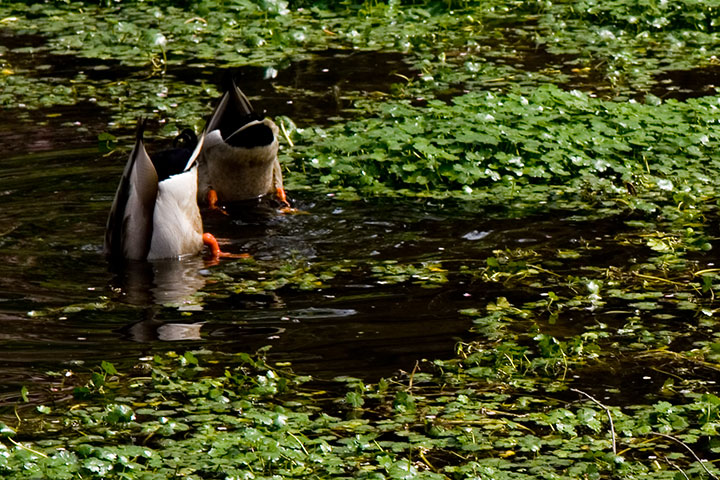
The ducks, however, were working overtime that day.
April 9th, 2009
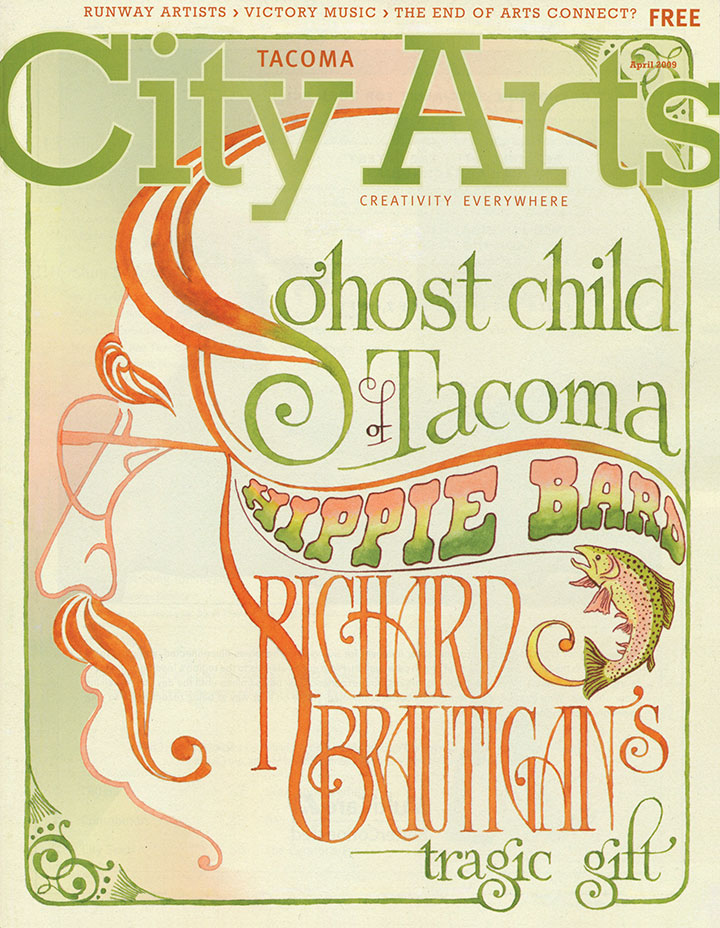
When I was growing up I used to raid my dad’s personal collection of books whenever I was looking for new reading material. We had bookcases all over the house, but I could always depend on Dad’s collection for the discovery of a new favorite. Those shelves introduced me to some of my favorite authors, and some of my most vivid memories are recalled passages from Steinbeck, Salinger, Pirsig, Robbins, etc. Dad’s bookcase also exposed me to some seriously weird stuff (which probably explains a thing or two about my tastes and personality), writing that I didn’t begin to understand until years later. One book that I went back to several times, attracted to its sheer strangeness, was Revenge of the Lawn, by Richard Brautigan—the title story was my favorite. I’m pretty sure most of the similes and imagery flew over my teenage head at the time, but I loved the fact that something could be so entertaining and emotional, and yet so bizarre. (And I fully blame Brautigan for my own rambling, tangential, parenthetical writing tendencies.)
Last month I got an email from City Arts, asking if I’d create some lettering and illustrations for a feature story they were doing on Richard Brautigan’s Tacoma roots. I did a double-take—wait a minute, Brautigan lived in Tacoma?
So I re-read “Revenge of the Lawn,” and was amazed at how much my new perspective of being a Washington/Tacoma resident changed the story for me. Even the more straightforward lines like “He was selling a vision of eternal oranges and sunshine door to door in a land where people ate apples and it rained a lot” took on an almost tangible layer of meaning. (I love that “I’ve Been There!” feeling when I read. It makes me want to run and tell everyone I know: See that passage there? I know exactly what he’s talking about!)
Illustrating Brautigan, or text about Brautigan, was a whole different matter, however. What could I possibly say with a picture what such a vividly visual writer hasn’t already said with words? This is the guy who wrote, “The creek was like 12,845 telephone booths in a row with high Victorian ceilings and all the doors taken off and all the backs of the booths knocked out,” after all.

I mulled it over for awhile, and decided to take him literally. This was a pretty odd experience for me, because I was always trained to make illustrations that add to or change the meaning of a text—and to avoid didactic images like the plague. Somehow, though, for this project, I felt that actually cramming as many Victorian-style phone booths as possible onto the spread would highlight the humor and absurdity of Brautigan’s words.
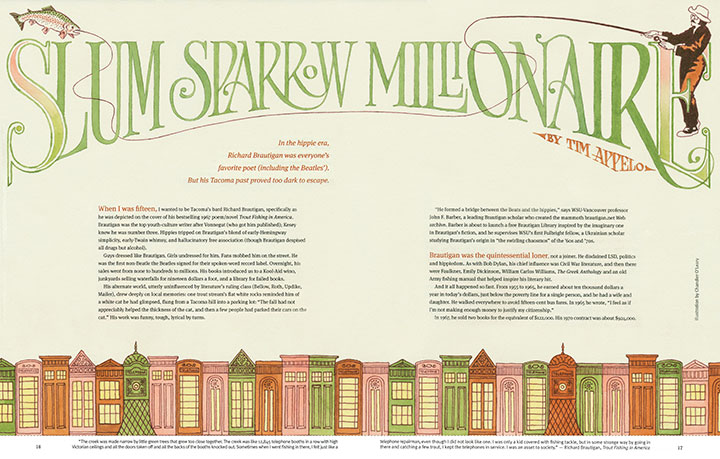
Or maybe I just really wanted to draw pictures of trout.
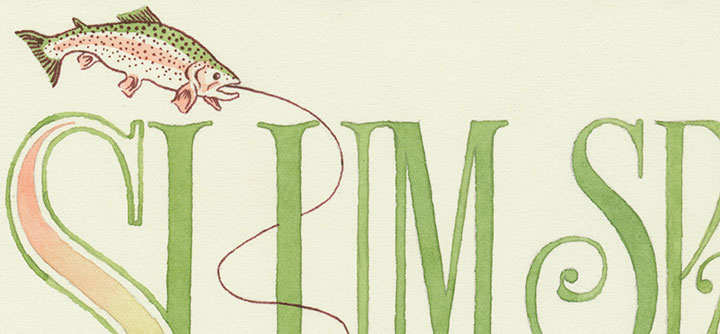
Anyway, the text is all hand-painted with watercolor in a “trouty” palette, and references Victorian-era typography and psychedelic graphic design (which itself references Victorian-era typography … the trout swallows its tail). If you’re local, you can pick up your copy for free at a whole slew of locations in and around Tacoma this month. The original watercolors are on display in the To the Letter exhibit through April 30.
![Chandler O'Leary [logo]](https://chandleroleary.com/wp-content/themes/chandleroleary/images/logo.png)










































































